FRUITS AND NUTS
/5 Comments/in Fruit/by Lee ReichAfter about twenty years of waiting, I happened to look at the ground and see a pine cone. The only pine tree nearby is a Korean pine (Pinus koreanensis) that I planted that many years ago, a tree that liked its new home and has soared, in that time, to fifty feet in height. My problem with the tree is that all it has done is grow; I planted the tree for its pine nuts.
A few years ago I did see a few cones way up near the top of the tree. Would the cones fall, carrying down the nuts, or would the nuts fall out, to be lost in the high grass? Would squirrels make all this moot?
I picked up the cone and clawed back its scales to see if any nuts were hiding within. Zut alors! Nuts! Most nuts need some curing before tasting good so I laid the cone in the sun for a few days.
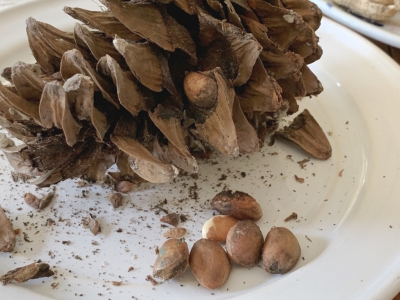
Tasting was next. First they needed to be cracked out of their shells, which was surprisingly easy with a pair of pliers. The first two nuts cracked were well filled and yielded delicious nuts. The next ten nuts, which comprised the rest of the harvest, when cracked, yielded nothing.
Many Nut Pines
The pine nuts you see for sale are generally one of the piñon pines native to the Southwest, the pignolia native to Italy and other Mediterranean countries, or Chinese white pine (Pinus armandii). In fact, though, a number of pine species provide edible nuts.
One of my favorites, the Digger pine (P. sabiniana), yields nuts the size of lima beans and is native to the foothills of the Sierra Nevada mountains. Driving west down those mountains many years ago, I came to a screeching stop (well, not really screeching) upon seeing the giant cone of this tree on the ground. I picked it up and must have provided entertainment, perhaps elicited fear, in passerbys seeing some guy smashing open a pine cone on the guard rail.
My Korean pine is a dead ringer for our native white pine, the latter of which does not yield edible nuts. Korean pine is only one of a number of nut pines that grows well in cold winter climates, such as Zone 5 here in this part of New York’s Hudson Valley. Swiss Stone pine (P. cembra) and Siberian pine (P. sibirico) are also reliable nut-producers for cold climates, but are very slow growing.
Many other pine species potentially could produce pine nuts outside their native range, though their adaptability to very cold winters climate is not thoroughly tested. The closely related Colorado Pinyon (P. edulis) and Singleleaf Pinyon (P. monophylla) pines are bushy trees that become flat-topped with age. I planted a Singleleaf pine years ago and though it tolerated the cold winters here, it’s annual growth measured in inches. With the slow growth and lack of nuts, I eventually tired of it.
Over the years, my pinetum (yes, that is a word) has expanded. A Lacebark pine ((P. bungeana), after five years or so in the ground, has finally taken off and is growing over a foot a year. This species is especially worth growing also for its decorative bark, which is a patchwork of muted colors.
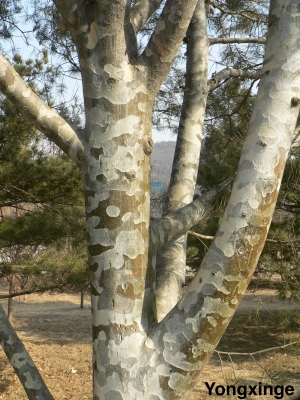
Blanks
Back to the blank shells borne by my Korean pine. One possibility is that this pine needs cross-pollination from another tree of the same species to bear nuts or, at least, to bear them well. The cone that I found lying on the ground was pretty soggy and might have been lying there for a year or more. Perhaps nuts within dried up and/or rotted away. I subsequently found three more soggy cones, all devoid even of nut shells.
I recently planted pollinators for the pine. They’re small, but after a couple of years of nurturing are finally growing well, the largest of the two now two feet tall. I’ll report back, hopefully in less than 20 years.
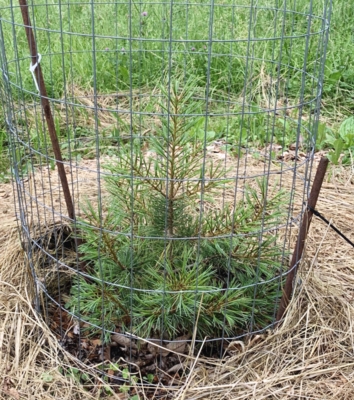
Survival of Fittest and Tastiest
On the bountiful side of the fruit and nut ledger this year are my tree fruits, especially the more common tree fruits. (Berries and uncommon tree fruits such as persimmon, mulberry, and cornelian cherry always do well here.) Winter and then spring weather were all perfect for a good set of fruit. Once that usually fraught time in fruit growing was passed, Mother Nature took over and the trees naturally shed fruits that had been poorly pollinated or insect ridden. That lets a tree channel its energies into making bigger and more flavorful the fruits that remained hanging on branches.

Nature’s aim in growing fruit is to make it appealing to all sorts of animals that incidentally spread the seeds as they eat the fruit. We humans are more discerning (would “finicky” be a better word?) when it comes to fruit quality. So once that natural fruit drop, “June drop” as it is appropriately called, is finished, we step in to remove even more fruit.
Pruning branches, on which some fruit would have been borne, in late winter and early spring already did some of that work. This week it was time to finish the job, by hand. This means putting some distance between each fruit and its neighbor, about five inches, always saving the largest and most pest free of the lot. Hand thinning would be tedious with smaller fruits, such as cherries and plums, so fortunately is unnecessary with them.
I ended up with a bucketful of cute apple and pear fruitlets. Cute, but into the compost they went where heat and time would cook any insect or disease pests lurking within that might have awakened to attack next year’s crop.
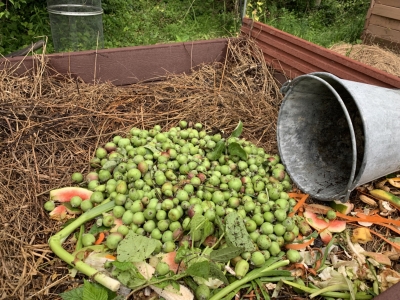
ROSES AND STRAWBERRIES AND — OH NO! — HONEYBERRIES
/23 Comments/in Flowers, Fruit/by Lee ReichRoses, Oh Yes
I bake really good bread, but “man can’t live by bread alone.” Sometimes, you’ve got to “stop to smell the roses.” Enough with the quotations! But back to the roses.
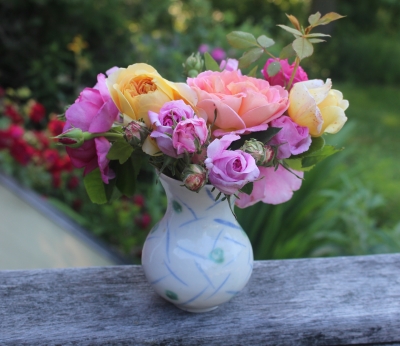
A love of roses has crept up on me over the years, due mostly to changes in kinds of roses available. Up until about 30 years ago, hybrid teas were pretty much the only roses on the block. These plants’ gangly stems are each capped by a vividly colored, fairly stiff, formal blossom whose petals wrap together into a pointy peak. You see where I’m going: hybrid teas are ugly, to me at least.
Also available were grandiflora and floribunda roses. Grandifloras are like hybrid teas, except their stems end with clusters of a few, but smaller, blossoms. Floribunda roses have even larger flower clusters of even smaller flowers. Despite being bushes more full with flowers than hybrid teas, grandiflora and floribunda flowers are still rather prim and proper except for their traffic-stopping colors.
Then so-called species and old-fashioned roses entered the scene, roses that are as nature made them or only slightly hybridized. These roses constitute broad groups, but generally, what they have going for them are more subdued — think pastel — colors and more blowsy blossoms on more heavily branching, fuller-bodied, shrubs.
The downside to species and old-fashioned roses, even if you like their blossoms and their growth habits, is that many bloom only in the spring. Hybrid teas pump out blossom after blossom all summer long.
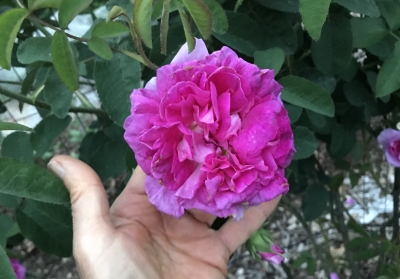
Rose d’Ipsahan
Enter Rose de Rescht, my first old-fashioned rose, given to me by a local, fellow gardener. Ann told me that this rose variety had soft pink flowers and heavenly scent. She was right about the appearance and fragrance, wrong about the name. After years of sleuthing, I’ve identified the rose as Rose d’Ispahan, probably originating in Persia but first discovered in a garden in Isfahan, Iran, renowned for its gardens and roses.
If I had to grow only one variety of rose, Rose d’Ispahan would be the one, for the beauty of its flowers, for its intense fragrance, for its cold-hardiness, for its lack of large thorns, and for its pest resistance. And that’s even though it blossoms only in spring. (It does so over a long period, though.)

Rose d’Ipsahan
But I don’t have to grow only one variety of rose. My other favorites are some of rose breeder David Austin’s varieties which combine the pest resistance and repeat blooming of modern roses with the blowsy, fragrant, pastel colored blossoms and full-bodied shrubs of old fashioned roses. My currant, and perhaps all-time, favorites are Lady of Shallot and, in my opinion needing a more euphonious name, Golden Celebration.
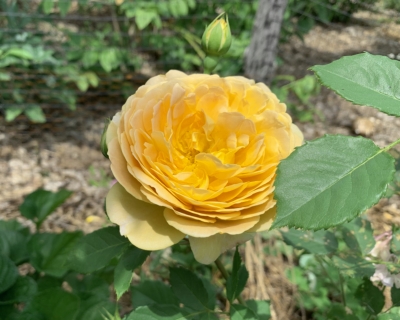
Golden Celebration rose
Both sport yellow — no, Golden! — blossoms, some apricot in those of Lady of Shallot, and a rich yellow, all contained in a petal-filled cup-shape in those of Golden Celebration. Another of my favorites, Lady Judi Dench, never woke up in spring a year ago; perhaps it was the cold, perhaps something else.
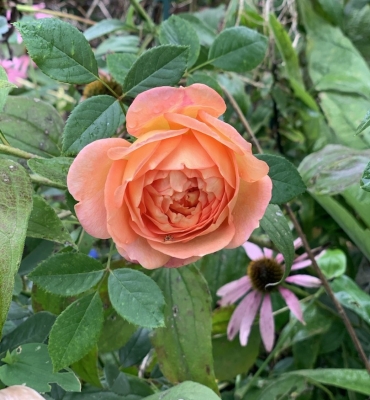
Lady of Shallot rose
I also grow another David Austin Rose, LD Braithewaite, with deep red blossoms and dark green, slightly reddish leaves. Not my favorite as far as appearance but this rose is very cold hardy and pumps out tons of blossoms almost all season long.
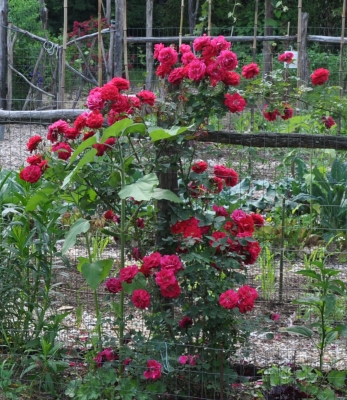
LD Braithewaite rose
And Strawberries, Oh Yes
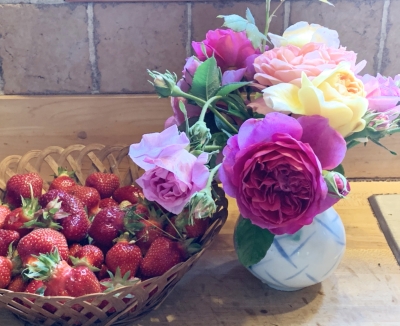 On to strawberries. I’m growing three kinds: the Pineapple Crush variety of white alpine strawberries; the Earliglow variety of garden strawberry; and a few varieties of vescana strawberries, which are hybrids of garden and alpine strawberries. This also is the order, starting with the best, of flavor for the three types.
On to strawberries. I’m growing three kinds: the Pineapple Crush variety of white alpine strawberries; the Earliglow variety of garden strawberry; and a few varieties of vescana strawberries, which are hybrids of garden and alpine strawberries. This also is the order, starting with the best, of flavor for the three types.
Why do I grow anything but the best? Because alpines are so small that it’s hard to fill a bowl with them. I grow vescanas, for the first time this year, because I never grew them before.
The Earliglow berries taste good and do quickly fill a bowl, ideally yielding one quart of berries per plant over the course of the season. Except this year, a problem has surfaced. Leather rot is a fungal disease (Phytophthora cactorum) that rears its ugly head — infected berries that taste bitter and have white patches that turn brown — usually following excessively wet periods from late spring to early summer, which is odd because weather has been on the dry side. Also odd because I’ve never seen the problem here before.
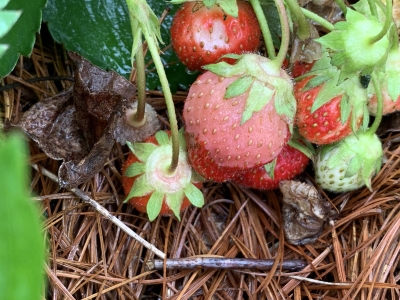
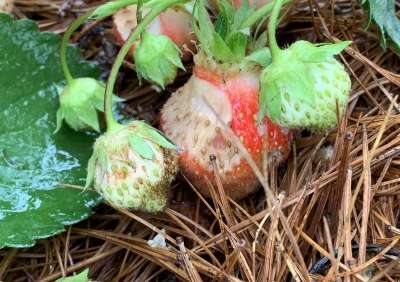
Which brings me back to vescana and Pineapple Crush. Both are very disease resistant, and vescana berries are almost as big as garden strawberries, so I’m thankful to have them, even if they do taste like canned strawberries.
And Honeyberries, Oh NO!
After three weeks of hanging on (the berries, not me), honeyberries, which are edible honeysuckles, are ready for a fair tasting. I wrote previously about the awful flavor of this new fruit and was instructed to let the berries hang till dead ripe.

The berries sampled this year were so ripe that each had to be plucked from the branch with my palm facing upwards beneath the berry; a mere touch would cause ripe ones to drop.
Rat-a-tat-tat-tat-tat (a drum roll). First to be tasted was the variety Solo. Reaction: spit it out quickly. Tart with bad flavor. Second fruit tasted was Sugar Mountain Blue. Also spit out, but not quite as quickly. And finally, Sugar Mountain Eisbär. Although retained in the mouth and having a hint of sweetness, this one, like the others, had bad flavor.
The flavor of honeyberries is allegedly like a mix of blueberry and raspberry. Not so! If you have space, plant blueberries or raspberries instead.
Free webinar today, WEEDLESS GARDENING
/0 Comments/in Gardening/by Lee Reich“WEEDLESS GARDENING” webinar
Are you interested in having a weedless garden this season? Yes? Learn how at my upcoming WEEDLESS GARDENING webinar. The system I’ll describe does more that just deal with weeds. It also lets your garden use water more efficiently, conserves valuable soil organic matter, lets you plant earlier in spring, and does not disrupt beneficial fungi and other friendly soil organisms. Starting a new garden? Here’s the fastest way to get the soil prepared and plants growing.
I’ll cover all this, and more, in the WEEDLESS GARDENING webinar. The webinar is free, at 2 pm EST on Sunday, June 6, 2021.
This webinar is sponsored by Inniswood Garden Society. To register for this program, please visit: www.bit.ly/AnnualMtgRegister

